Aviation against tanks (part of 14)
In the post-war period, with the advent of the “jet era”, combat aircraft with piston engines remained in service for quite some time in the USA and Great Britain. So, the American piston attack aircraft A-1 Skyraider, which made its first flight in March 1945, was used by the American armed forces until 1972. And in Korea, along with the reactive Thunderjets and Sabers, the piston Mustangs and Corsairs flew. The fact that the Americans were in no hurry to abandon the seemingly hopelessly outdated aircraft was associated with the low efficiency of jet fighter-bombers in carrying out immediate tasks aviation support. Too high a speed of jet aircraft made it difficult to detect point targets. And low fuel efficiency at first and low payload did not allow to surpass the machines created during the Second World War.
In the 50-60 years, not a single combat aircraft was designed to be used over the battlefield and combat armored vehicles in conditions of strong anti-aircraft resistance. In the West, they relied on jet fighters-bombers with a cruising flight speed of 750-900 km / h.
In the 50s, the main strike aircraft of the NATO countries was the F-84 Thunderjet. The first truly effective modification was the F-84E. A fighter-bomber with a maximum take-off weight of 10250 kg could take a combat load with a weight of 1450 kg. The combat radius without PTB was 440 km. The Thunderjet, which first flew into the air in February 1946, was one of the first American fighter jets, and had a straight wing. In this regard, its maximum speed at the ground did not exceed 996 km / h, but at the same time, due to its good maneuverability, the aircraft was well suited to the role of a fighter-bomber.
The Thunderjet’s built-in armament consisted of six 12,7 mm machine guns. Air bombs weighing up to 454 kg or 16 mm NAR could be placed on the external sling. Very often during the fighting on the Korean peninsula, the F-127 attacked targets with 84HVAR missiles. These missiles, adopted in 5, could be successfully used to combat tanks.
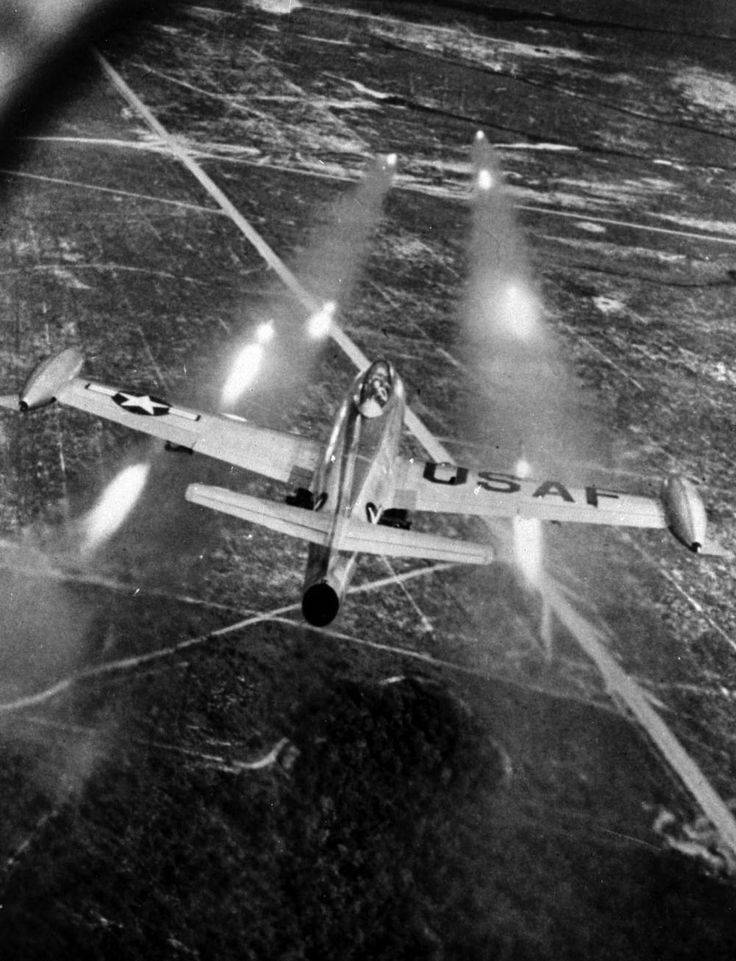
Due to the high efficiency of 127-mm unguided missiles during the fighting, the number of suspended NARs on the F-84 was doubled. However, the losses of the North Korean tank crews directly from the strikes of combat aviation of the “UN troops” were relatively small.
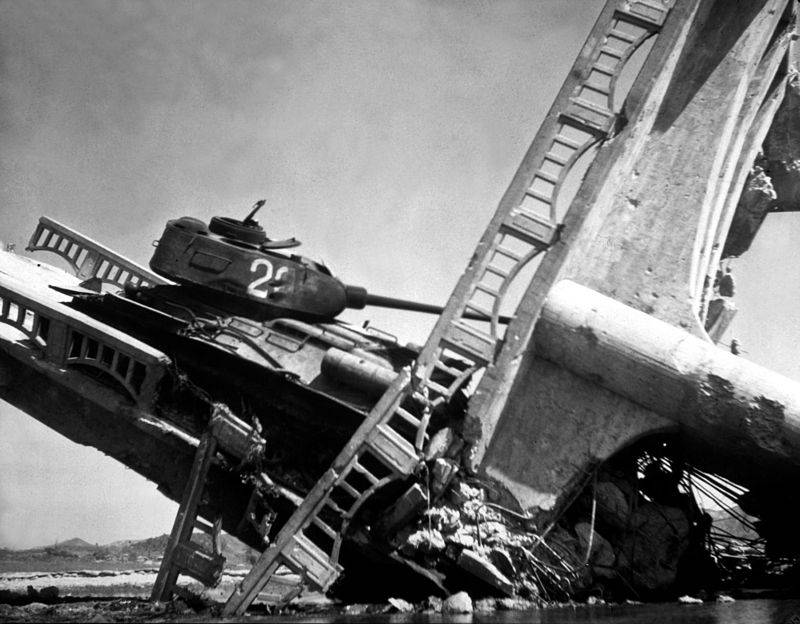
The offensive impulse of military units of the DPRK and the "Chinese people's volunteers" dried up when the supply of ammunition, fuel and food was stopped. American aircraft successfully destroyed bridges, ferries, trashed railway junctions and convoys. Thus, not being able to effectively deal with tanks on the battlefield, fighter-bombers made their progress without proper rear support impossible.
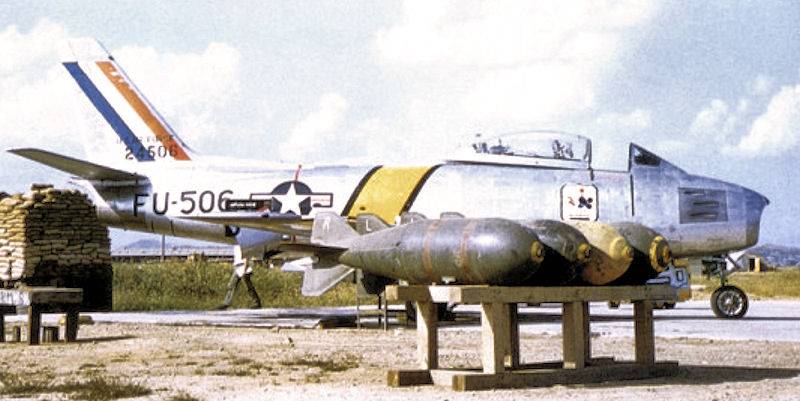
Another fairly common western fighter-bomber was the Saber F-86F modifications. In the middle of the 50-x in the United States has already begun the production of supersonic combat aircraft, and therefore subsonic fighters actively transferred to the allies.
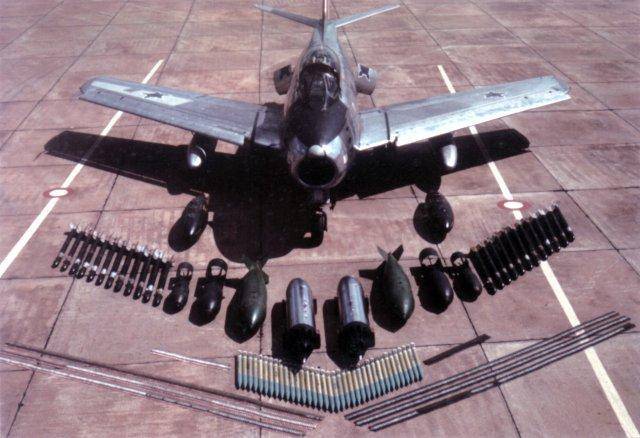
On four suspension nodes, the F-86F could carry napalm tanks or bombs with a total weight of up to 2200 kg. From the very beginning of the mass production of the fighter of this modification, the 16 NAR 5HVAR suspension was available; in 60-ies, units with 70-mm unguided Mk 4 FFAR missiles were introduced into its armament. Built-in weapons consisted of 6 heavy machine guns or four 20-mm guns. The plane with a maximum take-off weight of 8 230 kg at the ground developed the speed of 1106 km / h.
The main advantage of the “Sabr” over the “Thunderjet” was the greater thrust-to-weight ratio, which gave a better rate of climb and good take-off and landing characteristics. Although the flight data of the F-86F was higher, the strike capabilities of the machines were about the same.
The approximate analogue of Thunderjet was the French Dassault MD-450 Ouragan company. The aircraft with a maximum take-off weight of about 8000 kg, accelerated from the ground to 940 km / h. Combat radius of action - 400 km. Built-in weapons included four 20-mm guns. On two suspension nodes were placed bombs weighing up to 454 kg or NAR.
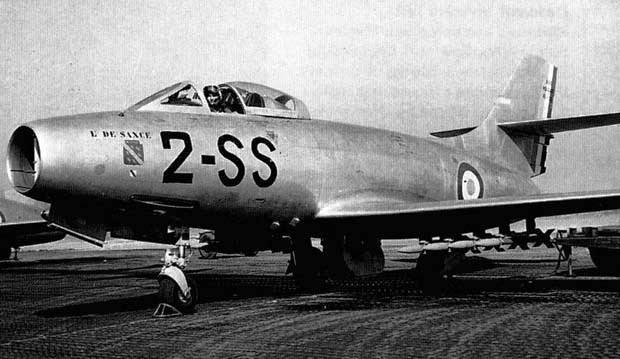
Although the total circulation of the built "Hurricanes" was approximately 350 units, the aircraft actively participated in the hostilities. In addition to the French Air Force, he was in service with Israel, India and El Salvador.
A good potential in the fight against armored had a British Hawker Hunter. This subsonic fighter, which first flew into the air in the summer of 1951, was to carry out the air defense of the British Isles, receiving commands from ground radar stations. However, as an air defense fighter due to the increased speed of the Soviet bombers, the Hunter was very quickly outdated. At the same time, it was relatively simple, had a sturdy, well-made glider and powerful built-in armament, consisting of a four-barreled battery 30-mm guns "Aden" with 150 ammunition shells on the barrel and good maneuverability at low altitudes. Fighter-bomber Hunter FGA.9 with a maximum take-off weight of 12000 kg, could take a combat load of 2700 kg weight. The combat radius reached 600 km. Maximum ground speed is 980 km / h.
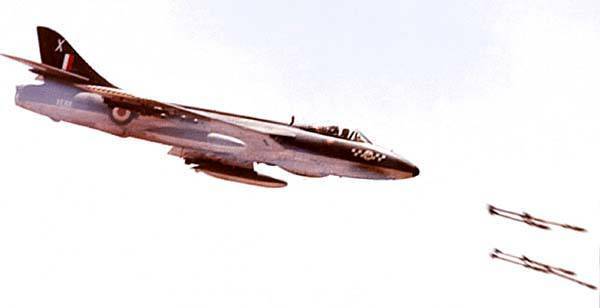
The conservative British retained the same unguided missiles that the Typhoon and Tempests pilots destroyed German tanks as part of the Hunter’s weapons. Fighter-bomber "Hunter" on antitank capabilities significantly superior to Saber and Thunderjet. This aircraft has proven itself very well in the Arab-Israeli and Indo-Pakistani conflicts, remaining in the ranks until the beginning of the 90-s. Simultaneously with the "Hunters" in India and the Arab countries, Soviet fighters, Su-7B bombers, were in service, and it was possible to compare the two vehicles in actual combat, including when attacking armored vehicles. It turned out that the "Hunter" with a lower maximum flight speed, due to better maneuverability, is more suitable for operations at low altitude as an aircraft of direct aviation support. He could take more bombs and rockets and, with equal caliber of guns, had a greater mass of volley. In the Indian Air Force at the beginning of the 70's, the existing “Hunters” adapted 68-mm cumulative French-produced CAPs and Soviet cluster bombs equipped with PTAB for suspension. This, in turn, significantly increased the anti-tank potential of the fighter-bomber. When attacking a point target, the review from the Hunter cockpit was better. The combat survivability of the machines was about the same level, but the Su-7B, due to the higher flight speed, could quickly get out of the range of the anti-aircraft artillery.
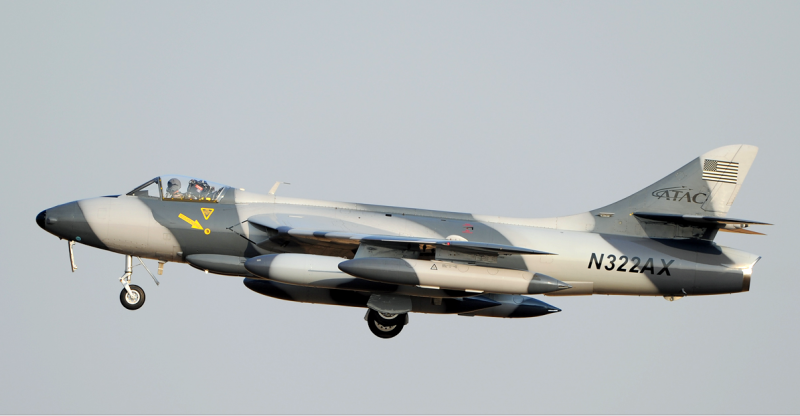
The Hunter strike options were valued for reliability, simple and relatively inexpensive maintenance, and unpretentiousness to the quality of the runways. It is noteworthy that the former Swiss “Hunters” are still used by the American private military aviation company ATAK, to imitate the exercises of Russian attack aircraft.
Before the start of the 60s, the air forces of the NATO countries mainly were dominated by American and British combat aircraft, which by no means satisfied the European aircraft manufacturers. In France, MD-454 Mystère IV and Super Mystère were used as fighter bombers, which were descended from the Hurricane.
The French Misters were solid middling; they did not shine with very high flight data or original technical solutions, but they were quite appropriate for their purpose. Although the French fighter-bombers of the first generation performed well in the Indo-Pakistani and Arab-Israeli wars, they did not find buyers in Europe.
The Super Mister, loaded with fuel and weapons, weighed 11660 kg. At the same time he could take up to a ton of combat load. Built-in weapons - two 30-mm DEFA 552 guns with 150 rounds of ammunition per barrel. Maximum airspeed at high altitude, without external suspensions - 1250 km / h. Combat radius - 440 km.
In the second half of the 50-x competition was announced for a single lightweight strike aircraft of NATO. The generals wanted to get a light fighter-bomber with flight data of the American F-86F, but more adapted for operations at low altitudes and better forward-down view. The plane was supposed to be able to conduct a defensive air battle with Soviet fighters. The built-in armament was to consist of 6 heavy machine guns, 4 20-mm guns or 2 30-mm guns. Combat load: 12 unguided 127-mm missiles, or two 225 kg bombs, or two napalm tanks, or two hanging machine-gun cannons, weighing up to 225 kg each. Great attention was paid to survivability and resistance to combat damage. The cabin of the aircraft from the front hemisphere should have been covered with frontal bulletproof glass, as well as to have protection of the lower and rear walls. Tanks with fuel had to withstand a chamber without leaks 12,7-mm bullets, fuel lines and other important equipment were proposed to be placed in the least vulnerable areas for anti-aircraft fire. The onboard radio-electronic equipment of the light strike aircraft was provided for as simple as possible, providing the possibility of using during the day and in simple meteorological conditions. The minimum cost of the aircraft itself and its life cycle were specifically stipulated. A prerequisite was the possibility of basing on unpaved airfields and independence from a complex airfield infrastructure.
The competition was attended by interested European and American aircraft manufacturers. Projects were funded by the United States, France and Italy. At the same time, the French strenuously pushed their Dassault Mystere 26, while the British were counting on a victory for Hawker Hunter. To their deep disappointment, Italian Aeritalia FIAT G. 1957 was declared the winner at the end of 91 of the year. This plane was in many ways reminiscent of the American "Saber". Moreover, a number of technical solutions and nodes were simply copied from the F-86.
The Italian G.91 turned out to be very light, its maximum take-off weight was record low - 5500 kg. In the horizontal flight, the plane could reach speeds of 1050 km / h, the combat radius was 320 km. Originally built-in weapons included four 12,7-mm machine guns. On the four suspension assemblies under the wing there was a combat load of 680 kg mass. To increase the flight range, instead of armament, two discharged fuel tanks with a capacity of 450 liters were suspended.
Military tests of the G.91 pre-production batch, conducted by the Italian Air Force in 1959, demonstrated the aircraft’s simplicity for home-based conditions and the ability to operate from poorly prepared unpaved runways. All ground equipment necessary for flight preparation was transported on ordinary trucks, and could be quickly deployed to a new location. The launch of the aircraft engine was carried out by a starter with a pyro cartridge and did not require compressed air or a power supply connection. The entire training cycle of a fighter-bomber for a new combat flight took no more than 20 minutes.
According to the “cost-effectiveness” criterion in 60-ies, G.91 almost ideally suited the role of a mass light fighter-bomber and fully complied with the requirements for a single NATO strike aircraft, but due to national egoism and political disagreements, it was not widely used. In addition to the Italian Air Force, G.91 adopted in the "Luftwaffe".
German light attack aircraft differed from the Italian machines with enhanced built-in armament, consisting of two 30-mm DEFA 552 cannons with an 152 projectile ammunition. The wing of the German cars strengthened, which made it possible to accommodate two additional pylons of weapons.
Operation G.91 in Germany continued until the beginning of the 80-x, the pilots loved these simple and reliable machines and subsequently reluctantly transplanted to the supersonic "Phantoms" and "Starfighters". Due to the good maneuverability of the G.91 point targets, it was not only superior to many of its peers, but also much more complex and expensive combat aircraft that appeared in the 70-80-s. During the exercise, the Luftwaffe light attack aircraft repeatedly demonstrated the ability to accurately fire off cannons and NAR on decommissioned tanks at the range. Confirmation that G.91 was really a very successful aircraft, is the fact that several vehicles were tested in flight research centers in the US, UK and France. Italian cars everywhere have received positive reviews, but it did not go further. However, it is difficult to imagine that in 60-s, even if very successful, but developed and built in Italy, the combat aircraft was put into service in leading aviation Western countries. Despite the declared unity of NATO, orders for their own air forces have always been too tasty for national aircraft-building corporations to share with anyone.
On the basis of a more durable and roomy double training G.91T-3 in 1966, the lightweight G.91Y fighter-bomber with cardinally improved flight and combat characteristics was created. During test flights, its speed at high altitude came very close to the sound barrier, but flights in the altitude range 1500-3000 meters with speed 850-900 km / h were considered optimal.
On the plane installed two turbojet engines General Electric J85-GE-13, previously used on the F-5A fighter. Thanks to the use of a larger wing area with automatic slats throughout its span, it was possible to significantly increase maneuverability and take-off and landing characteristics. The strength characteristics of the wing allowed to increase the number of suspension points to six. Compared to G.91, the maximum take-off weight increased by more than 50%, while the weight of the combat load increased by 70%. Despite the increased fuel consumption, the flight range of the aircraft increased, helped by an increase in the capacity of the fuel tanks by 1500 liters.
Due to the combination of low cost and quite good flight and combat characteristics, the G.91Y aroused interest among foreign buyers. But relatively poor Italy could not supply aircraft on credit, and exert the same political pressure as the overseas "big brother". As a result, in addition to the Italian Air Force, who ordered the 75 aircraft, there were no other buyers for this reasonably successful car. It is safe to say that if G.91 was created in the USA, it would be much more widespread, could be involved in many armed conflicts and, possibly, would be in operation until now. Subsequently, some technical and conceptual solutions worked out on the G.91Y were used to create the Italian-Brazilian light attack aircraft AMX.
In 50-60-ies, the improvement of combat aviation proceeded along the path of increasing the speed, altitude and range of the flight and increasing the weight of the combat load. As a result, heavy supersonic F-70 Phantom II, F-4 Thunderchief and F-105 Aardvark became the main US Air Force impact machines at the beginning of the 111's. These vehicles were optimally suited for delivering tactical nuclear bombs and striking conventional munitions at enemy troop convoys, headquarters, airfields, transportation hubs, warehouses, fuel depots, and other important targets. But for the provision of direct aviation support, and even more so the struggle with tanks on the battlefield, heavy and expensive aircraft were of little use. Supersonic fighter-bombers could successfully solve the problem of isolating the battlefield, but for the immediate destruction of armored vehicles in combat formations required relatively light and maneuverable combat aircraft. As a result, the Americans were forced to retrain the F-100 Super Saber fighter-bomber for the name of the best. This supersonic fighter was of the same age and exemplary analogue of the Soviet MiG-19. An aircraft with a maximum take-off weight of 15800 kg could take on six underwing pylons to 3400 kg of bombing or other weapons. There were also four built-in 20-mm guns. The maximum speed is 1390 km / h.
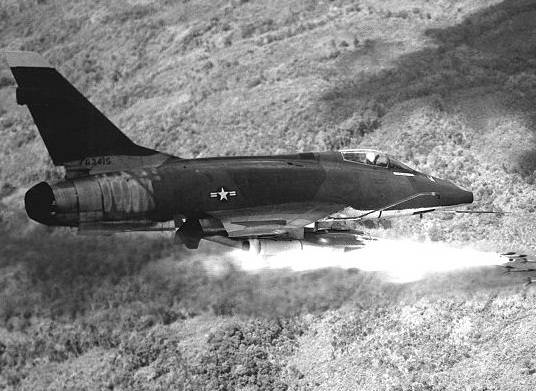
“Super Saber” was very actively used by the US Air Force during the fighting in Southeast Asia and the French Air Force in Algeria. Compared to the F-4 and F-105, which had a higher payload capacity, the F-100 showed much better accuracy in air strikes. What was especially important when operating near the line of contact.
Almost simultaneously with the F-100 fighter, the A-4 Skyhawk light attack aircraft developed for the US Navy and USMC was adopted. With relatively small size single-engine "Skyhawk" had a fairly high combat potential. The maximum speed was 1080 km / h. Combat radius - 420 km. With a maximum take-off mass of 11130 kg, he could take on the 4400 kg payload on five suspension nodes. Including four LAU-10 four-charge launchers for 127-mm NAR Zuni. These rocket projectiles in terms of weight and size characteristics, launch range and the destructive effect of the high-explosive fragmentation warhead are close to the Soviet NAR C-13.
Apart from the piston "Skyrader", of all the aircraft that were in the American armed forces, by the beginning of the Vietnam War, "Skyhawks" were best suited for fire support of ground forces and the destruction of mobile targets on the battlefield.
However, during the Doomsday War in 1973, Israeli A-4, operating against Syrian and Egyptian tanks, suffered heavy losses. The Soviet-style air defense system revealed the high vulnerability of light unarmored attack aircraft. If the US "Skyhawks" were mainly intended for use on aircraft carriers, then in Israel, which became the largest foreign customer (263 aircraft), these machines were considered solely as attack aircraft, designed for action on the front and rear of the enemy.
For the Israeli Air Force on the basis of the A-4E, a special modification of the A-4H was created. This vehicle was equipped with a more powerful Pratt & Whitney J52-P-8A engine with a thrust of 41 kN and improved avionics, and a number of measures to improve combat survivability were implemented on this modification. In order to increase the anti-tank potential, the 20-mm American guns were replaced by two 30-mm ones. Although the 55-mm armor-piercing shells were ineffective against Soviet tanks T-62, T-3 and IS-30M, they easily penetrated the relatively thin armor of the BTR-152, BTR-60 and BMP-1. In addition to the onboard cannons, the Israeli Skyhawks used unguided missiles and cluster bombs with cumulative submunitions on armored vehicles.
To replace the A-4 Skyhawk in 1967, the US Navy’s A-7 Corsair II began shipping to the US Navy’s deck assault squadrons. This machine was developed on the basis of the F-8 Crusader deck fighter. Compared to the light skyhook, it was a larger aircraft equipped with perfect avionics. Its maximum take-off weight was 19000 kg, and the possible weight of the suspended bombs was 5442 kg. Combat radius - 700 km.
Although the "Corsair" was created by order of the Navy, because of its relatively high characteristics, it was adopted by the Air Force. An attack aircraft very actively fought in Vietnam, making about 13000 combat missions. In the squadron specializing in search and rescue of pilots, the jet "Corsair" replaced the piston "Skyrader".
In the mid-80s, as part of a project to develop a promising anti-tank attack aircraft designed to replace the A-10 Thunderbolt II based on the A-7D, the design of the supersonic A-7P began. A radically modernized attack aircraft with a fuselage of increased length due to the installation of a Pratt & Whitney F100-PW-200 turbojet engine with an afterburner thrust of 10778 kgf was supposed to be turned into a highly effective modern combat aircraft of the battlefield. The new power plant in combination with additional armor was to significantly increase the combat survivability of the aircraft, improve its maneuverability and acceleration characteristics.
The company Ling-Temco-Vought planned to build X-NUMX attack aircraft A-337P, using the elements of the airframe serial A-7D. At the same time, the cost of one aircraft was only $ 7 million, which is several times less than the cost of purchasing a new attack aircraft with similar combat capabilities. As planned by the designers, the upgraded attack aircraft should have maneuverability comparable to Thunderbolt, with much higher speed data. On tests that began in 6,2, the experienced YA-1989P exceeded the speed of sound, speeding up to the 7M. According to preliminary calculations, the aircraft with four AIM-1,04L Sidewinder air combat could have a maximum speed of more than 9M. However, after about a year and a half, in connection with the end of the Cold War and the reduction of defense spending, the program was closed.
In the middle of 60's, the United Kingdom and France concluded an agreement on the creation of a joint aircraft of direct aviation support. At the first stage of creating a new shock machine, the sides strongly disagreed on the technical appearance and flight data of the aircraft. So, the French were quite comfortable with an inexpensive light attack aircraft, comparable in size and capabilities to the Italian G.91. At the same time, the British wanted to have a supersonic fighter-bomber with a laser range finder-pointer and advanced navigation equipment, providing combat use at any time of the day. In addition, at the first stage, the British insisted on a variant with a variable geometry of the wing, but due to the increased cost of the project and the delay in development, it was subsequently abandoned. However, the partners were unanimous in one thing - the plane had to have an excellent view forward — downward and powerful strike armament. Prototype construction began in the second half of 1966. The UK placed an order for 165 combat and 35 two-seat training aircraft. The French Air Force wanted 160 combat aircraft and 40 sparks. The shipments of the first production vehicles to the combat squadrons began in 1972.
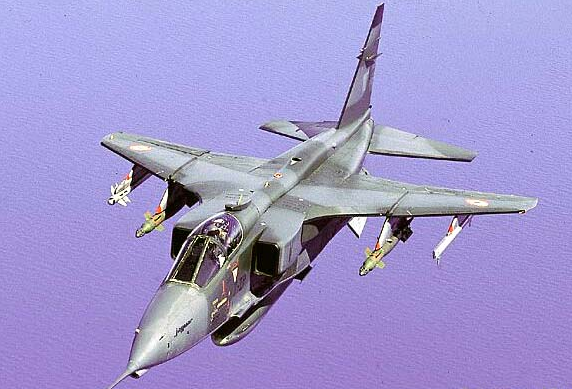
The aircraft destined for the British Royal Air Force (RAF) and the French Armée de l'Air were significantly different in their avionics. If the French decided to go on the way to reduce the cost of the project and get by with the minimum necessary sighting and navigation equipment, then the British Jaguar GR.Mk.1 had a built-in laser range-finder and indicator on the windshield. Externally, the British and French "Jaguars" differed in the shape of the bow, the French had it more rounded.
The Jaguars of all modifications installed the TACAN navigation system and VOR / ILS landing equipment, meter and decimeter radio stations, equipment for state recognition and warning of radar exposure, onboard computers. The French Jaguar A had a Decca RDN72 Doppler radar and an ELDIA data recording system. British single Jaguar GR.Mk.1 equipped PRNK Marconi Avionics NAVWASS with information output on the windshield. Navigation information on British aircraft after processing the onboard computer was displayed on the indicator "moving map", which greatly facilitated the withdrawal of the aircraft to the target in conditions of poor visibility and during flights at extremely low altitudes. In the course of long-range raids, fighter-bombers could replenish their fuel with the help of an in-flight refueling system. At first, the reliability of the propulsion system, consisting of two Rolls-Royce / Turbomeca Adour Mk 102 TRDDFs with the unforced 2435 kgf and 3630 kgf, left a lot to be desired at the afterburner. However, by the middle of 70's, the main problems were resolved.
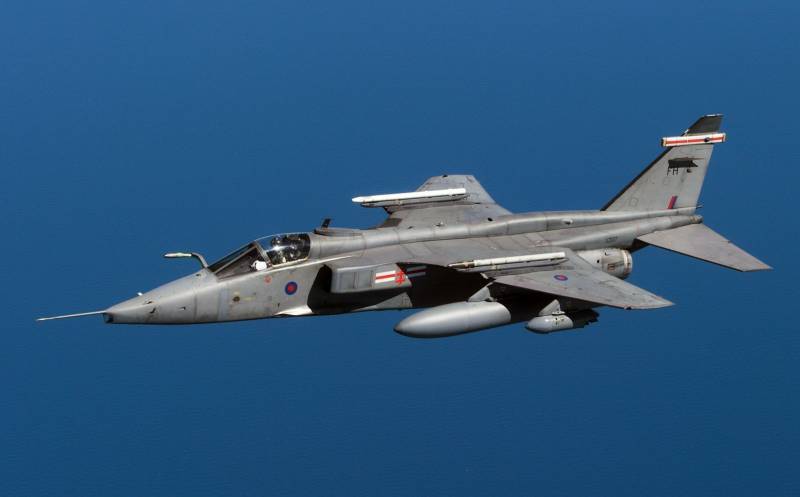
Certain differences were in the composition of weapons. French fighter-bombers armed themselves with two 30-mm cannon DEFA 553, and British 30-mm ADEN Mk4 with a total ammunition 260-300 shells. Both artillery systems were created based on German developments from the Second World War and had a rate of fire of 1300-1400 rounds / min.
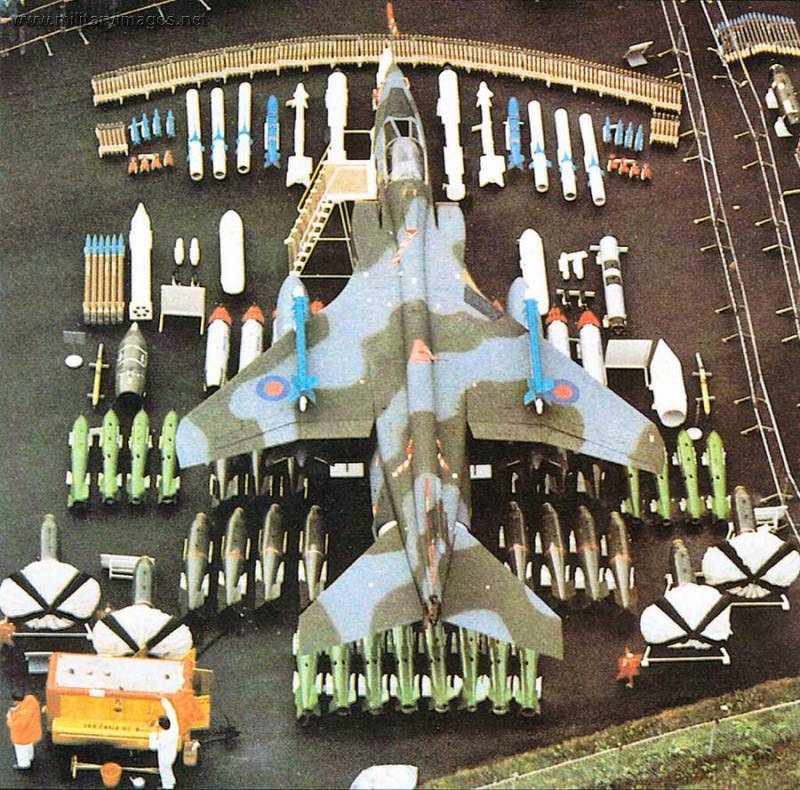
A combat weight of up to 4763 kg could be placed on five external nodes. On British machines, air combat missiles were placed on pylons above the wing. The Jaguars could carry a wide range of guided and unmanaged weapons. At the same time the main anti-tank weapons They were 68-70-mm NAR with cumulative warheads and cluster bombs equipped with anti-tank mines and miniature cumulative bombs.
The aircraft was adapted for action at low altitudes. Its maximum ground speed was 1300 km / h. At the height of 11000 m - 1600 km / h. With a supply of fuel in the internal tanks 3337 liters of combat radius, depending on the profile of the flight and the combat load was 560-1280 km.
The first in 1977 year in the battle "Jaguars" tested the French. In the 70-80-ies France entered into a series of armed conflicts in Africa. If in Mauritania, Senegal and Gabon bombardment attacks on various types of partisan formations occurred with great efficiency without a loss, then in an attempt to counter Libyan armored vehicles in Chad three aircraft were shot down. The Libyan units operated under an air defense umbrella that included not only anti-aircraft artillery, but also mobile square-to-ground air defense systems.
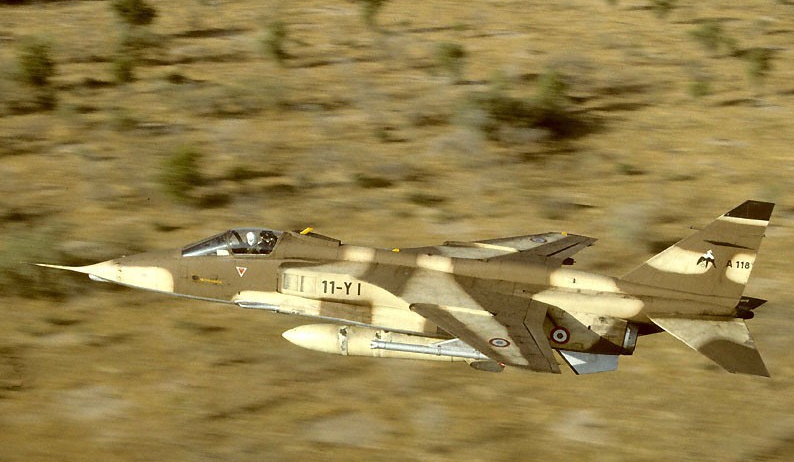
Although the Jaguars during their combat career showed very good resistance to combat damage, in the absence of armor and special measures to increase survivability, the use of aircraft of this type as an anti-tank attack aircraft was fraught with great losses. The experience of using the French, British and Indian "Jaguars" against an enemy with an organized air defense system showed that the pilots of fighter-bomber achieved the greatest success when striking cluster troop munitions and destroying critical targets with high-precision aviation weapons. The main anti-tank weapon of the French "Jaguars" during the "Storm in the Desert" became the cluster anti-tank bombs of the American production MK-20 Rockeye.
In the 220-kg cluster bombs contain about 247 compact cumulative fragmentation submunitions Mk 118 Mod 1. each weighing 600 g, with armor penetration along the normal 190 mm. When dumping from a height of 900 m, one cluster bomb covers an area approximately corresponding to a football field.
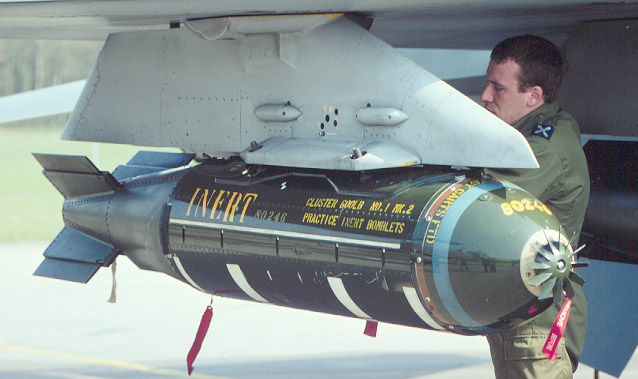
British fighter-bombers used 278 kg BL755 cassettes, each of which contained 147 cumulative fragmentation elements. The moment of disclosure of the cassette after a reset is determined using a radar altimeter. At the same time, small-sized bombs weighing about 1 kg are pushed out at certain intervals from the cylindrical compartments with a pyrotechnic device.
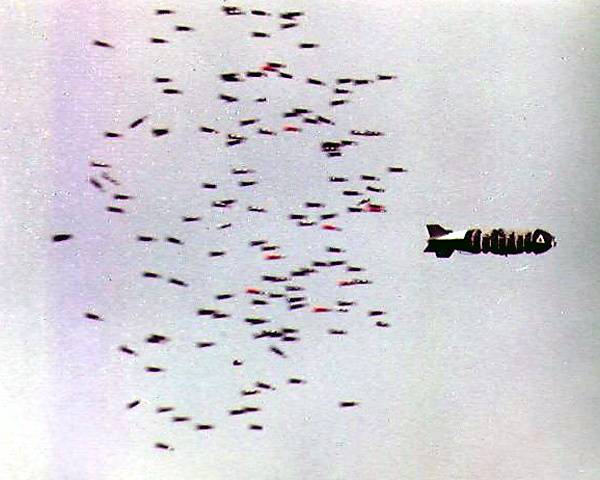
Depending on the height of the opening and the frequency of ejection from the compartments, the covering area is 50-200 m². In addition to the cumulative fragmentation bombs, there is a variant BL755, equipped with 49 anti-tank mines. Often, when attacking Iraqi armored vehicles, both versions were used simultaneously.
In the middle of the 70-s, the main striking force of the Luftwaffe was the American-made F-4F Phantom II and F-104G Starfighter fighter jets. If the main "children's sores" "Phantom" by the time it was eliminated and it really was a fairly perfect combat aircraft, the use of "Starfighter" as a fighter-bomber was absolutely unjustified. Although its own air force, after a short period of operation in the fighter-interceptor version, abandoned the “Star Fighter”, the Americans managed to push the F-104G as a multifunctional combat aircraft in the German Air Force.
Starfighter, which had swift outlines, looked very impressive during demonstration flights, but the plane with short thin straight wings had an unprecedented wing load - up to 715 kg / m². In this regard, the maneuverability of a thirteen-ton aircraft left much to be desired, and flights at low altitude, common to a bomber fighter, were deadly dangerous. Of the 916 F-104G set by the Luftwaffe, about a third of it was lost in accidents and disasters. Naturally, such a situation could not suit the West German generals. The Luftwaffe needed an inexpensive and simple combat aircraft capable of operating at low altitudes against tank wedges of the Warsaw Pact armies. The Italian-German G.91 completely satisfied these requirements, but by the beginning of the 70's he had become morally and physically obsolete.
At the end of 1969, an agreement was reached between France and the Federal Republic of Germany on the joint development of a lightweight shock twin-engined subsonic combat aircraft, which could also be used as a training aircraft. The machine, developed on the basis of projects Breguet Br.126 and Dornier P.375, received the designation Alpha Jet. At the first stage, it was planned that in each country participating in the project, 200 aircraft would be built. The requirements for the tactical and technical characteristics of the Alpha Jet were developed on the basis of the peculiarities of the fighting in the European theater, where there were more than 10000 units of Soviet armored vehicles and powerful military air defense, represented by both self-propelled anti-aircraft artillery systems and medium-range and short-range mobile air defense systems. And the course of the hostilities itself should have been distinguished by its dynamism and transience, as well as the need to combat the landings and block the enemy’s reserves approach.
The construction of light attack aircraft should have been carried out in two countries. In France, Dassault Aviation was identified as a manufacturer, and in Germany, Dornier was identified. Although the aircraft was originally planned to install American General Electric J85 TRDs, which were well-proven on TC-T-38 and F-5 fighters, the French insisted on using their own Larzac 04-C6, 1300 kgf. To avoid damage to one projectile engines were maximally spaced around the sides.
A simple and reliable hydraulic control system provides excellent piloting in all ranges of heights and speeds. During the test flights, the pilots noted that the “Alpha Jet” is difficult to drive into a tailspin, and he leaves it on his own when removing effort from the control stick and pedals. Considering the specificity of the use of the aircraft and flights at low altitudes in the zone of increased turbulence, the safety margin of the structure was very significant, the maximum calculated overloads are from + 12 to -6 units. During test flights, the Alpha Jet repeatedly exceeded the speed of sound during a dive, while maintaining adequate control, and there was no tendency to turn over or to delay in a dive. In the military units, the maximum speed without external hangers was limited to 930 km / h. The maneuverable characteristics of the attack aircraft made it possible to successfully conduct a close air combat with all types of fighters that were available at NATO in the middle of the 70's.
The first production Alpha Jet Es entered French squadrons in December 1977, and Alpha Jet A in the Luftwaffe six months later. The aircraft intended for operation in Germany and in France, differed in the composition of the avionics and weapons. The French focused on the use of two-seater jets as training aircraft. And the Germans in the first place needed a full-fledged light anti-tank attack aircraft. In this regard, the aircraft, built at the enterprise "Dornier", had a more advanced sighting and navigation system. France ordered 176, and FDR 175 aircraft. Another 33 Alpha Jet 1В very similar in composition to avionics of the French Alpha Jet E was delivered to Belgium.
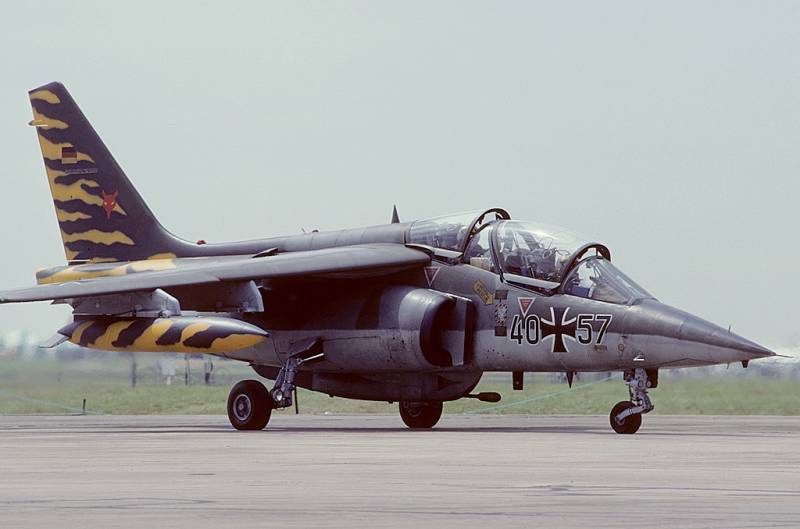
The equipment of the German "Alpha Jet" includes: TACAN navigation equipment, radio compass and blind landing equipment. The composition of avionics allows flying at night and in poor visibility conditions. The weapon control system, with a laser range finder built into the nose, with a target designator, makes it possible to automatically calculate the point of impact when bombing, launching unguided rockets and firing a cannon at land and air targets.
On the Luftwaffe planes, the 27-mm Mauser VK 27 gun with 150 rounds of ammunition is suspended in the suspended ventral container. When the weight of the gun without shells is about 100 kg, it has a firing rate of up to 1700 rds / min. An armor-piercing projectile with plastic leading corbels weighing 260 g leaves the barrel at a speed of 1100 m / s. An armor-piercing projectile with a hard-alloy core at a distance of 500 m along the normal is able to penetrate 40 mm armor. At the head of the projectile in front of the core there is a crushable part filled with cerium metal. At the time of the destruction of the projectile soft cerium, which has a pyrophoric effect, ignites spontaneously and when penetrating armor gives a good incendiary effect. The armor penetration capability of the 27-mm projectile is not enough to confidently fight medium tanks, but when firing on lightly armored vehicles, the effectiveness of the damage can be high.
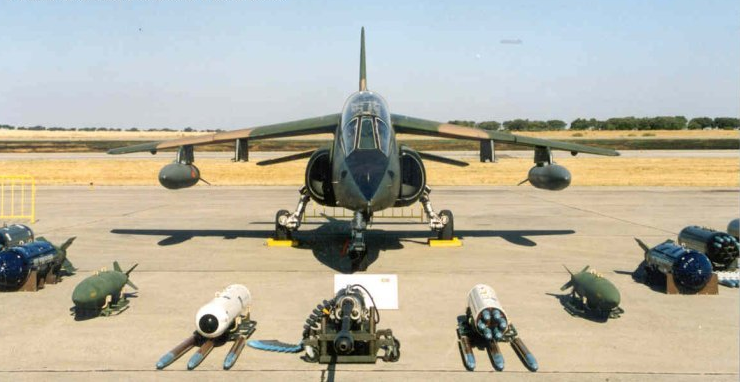
The armament of the West German aircraft, located on the five external suspension nodes with a total weight of up to 2500 kg, can be quite diverse, which allows solving a wide range of tasks. The West German command in the selection of the composition of the attack aircraft weapons paid great attention to anti-tank orientation. In addition to the cannon and the NAR, cluster bombs with cumulative ammunition and anti-tank mines were designed to combat Soviet armored vehicles. Also, “Alpha Jet” is able to carry hanging containers with 7,62 — 12,7-mm machine guns, bombs weighing up to 454 kg, napalm tanks and even sea mines. Depending on the mass of the combat load and the flight profile, the combat radius can be from 400 to 1000 km. When using outboard fuel tanks during reconnaissance missions, the range can reach 1300 km. With a sufficiently high combat load and flight range the aircraft turned out to be relatively light, the maximum take-off weight is 8000 kg.
The aircraft was well suited for basing on field unpaved airfields. Alpha Jet did not require sophisticated ground equipment, and the re-combat departure time was reduced to a minimum. In order to reduce the length of the run on the limited-length lanes, the Luftwaffe attack planes were installed landing hooks that clung to the landing for brake cable systems, similar to those used in carrier-based aircraft.
French aircraft were mainly used for training purposes. Since the Jaguar was the main striking machine in the French Air Force, the Alpha Jet E weapon was rarely suspended. However, it is possible to use the DEFA 30 553-mm cannon in the ventral container, the NAR and the bombs.
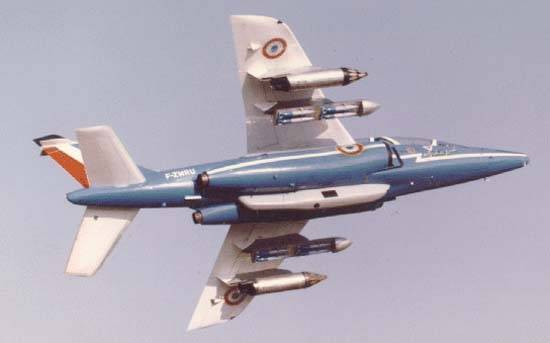
From the very beginning, the French side insisted on designing only a two-seater car, although the Germans were completely satisfied with the single-seater light attack aircraft. Not wanting to incur the additional cost of creating a single-seat modification, the Luftwaffe generals agreed with the two-seater cabin. The layout and placement of the cockpit provided a good forward-down view. The seat of the second member of the crew is located with some excess over the front, which provides an overview and allows you to independently carry out landing. Later, during the aerospace show, where the Alpha Jet was exhibited, it was repeatedly stated that the presence of aircraft controls in the second cockpit increases survivability, as in the event of a failure of the main pilot, the second can take control. In addition, as shown by the experience of local wars, the two-seater is much more likely to dodge an anti-aircraft missile and avoid defeat by anti-aircraft artillery fire. Since the pilot has a significantly reduced field of view during a ground target attack, the second member of the crew is able to inform about the danger in time, which gives enough time to perform an anti-missile or anti-aircraft maneuver, or allows them to evade an attack from a fighter.
Simultaneously with the entry into the flight units of the Alpha Jet A attack aircraft, the remaining G.91R-3 was decommissioned. Pilots with flight experience on the Fiat, noted that at a comparable maximum speed, the Alpha Jet is a much more maneuverable aircraft with significantly greater combat effectiveness.
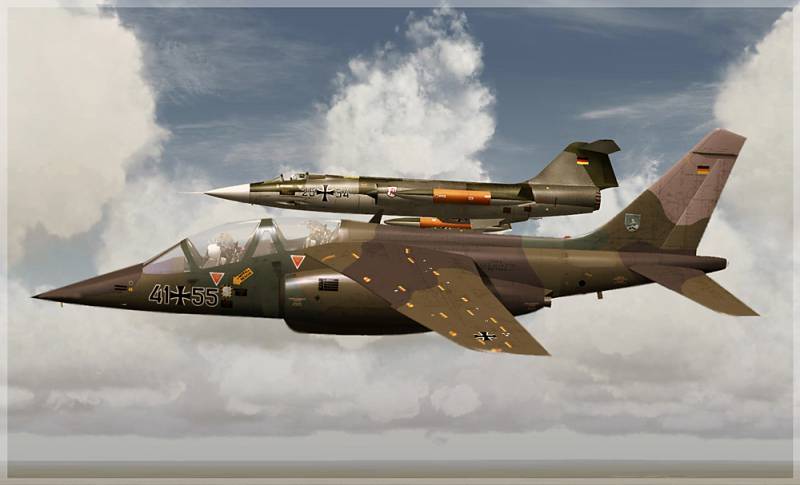
The Luftwaffe pilots particularly liked the attacker's ability to replay fighters in air combat. With competent tactics of air combat, the Alpha Jet could become a very difficult adversary. Repeated training air battles with the F-104G, Mirage III, F-5E fighters and even with the latest F-16A at that time showed that if the attack aircraft crew detected the fighter on time and then got up at low speed, turn his sight became very difficult. If the fighter pilot tried to repeat the maneuver and was drawn into the battle on turns, then he himself soon came under attack.
According to the characteristics of horizontal maneuverability, only the British “Harrier” VTOL aircraft could be compared to the “Alpha Jet”. But with comparable combat effectiveness of ground targets, the cost of the Harrier itself, its operating costs and preparation time for combat mission were much higher. Despite the seemingly modest flight data on the background of supersonic machines stuffed with sophisticated electronics, the West German light attack aircraft fully complied with the requirements set for it and showed very high indicators on the “cost-effectiveness” criterion.
Although the maneuverability characteristics of the Alpha Jet at the ground surpassed all existing NATO combat aircraft at that time, the saturation of the European theater of military air defense weapons made the survival of a German attack aircraft problematic. In conjunction with this, a program to increase combat survivability was launched at the beginning of 80's. Measures were taken to reduce radar and thermal visibility. On the upgraded aircraft installed devices for shooting heat traps and dipole reflectors, as well as the American suspension equipment for making active jamming stations targeting anti-aircraft missiles. The structure of weapons introduced American guided missiles AGM-65 Maverick, capable of destroying point targets on the battlefield, beyond the limits of the anti-aircraft installations.
I must say that the resistance to combat damage at Alpha Jet was initially not bad. The well-thought-out layout, the duplicated hydraulic system and the separated engines, even with the defeat of the Strela-2 MANPADS, gave chances to return to their own airfield, but tanks and fuel lines required additional protection against lumbago.
The calculations showed that in case of failure of the double cabin, the released mass reserve could be directed to increase security. The single version of the attack aircraft received the designation Alpha Jet C. It differed from the basic two-seat modification with an armored cab that withstand shelling from 12,7-mm machine guns and a straight wing with six suspension nodes and more powerful engines. Fuel tanks and fuel lines were supposed to hold rifle caliber armor-piercing bullets. It was assumed that the combat effectiveness of a single attack aircraft compared with the Alpha Jet A will double. In the case of the project in the "Luftwaffe" could appear attack aircraft, comparable in its characteristics with the Soviet Su-25. The specialists of the Dornier Company carried out a rather deep study of the project documentation, but when the question arose of building a prototype, there was no money in the military budget of Germany.
To be continued ...
Based on:
http://techno-story.ru/articles/aircrafts/424-reaktivnyj-grom-nad-koreej-f-84-thunderjet
http://www.fighter-planes.com/info/g91.htm
https://www.copybook.com/news/sale-or-scrap-israels-military-equipment-disposals
https://www.globalsecurity.org/military/systems/munitions/mk20.htm
http://en.valka.cz/topic/view/64335/GBR-BL-755
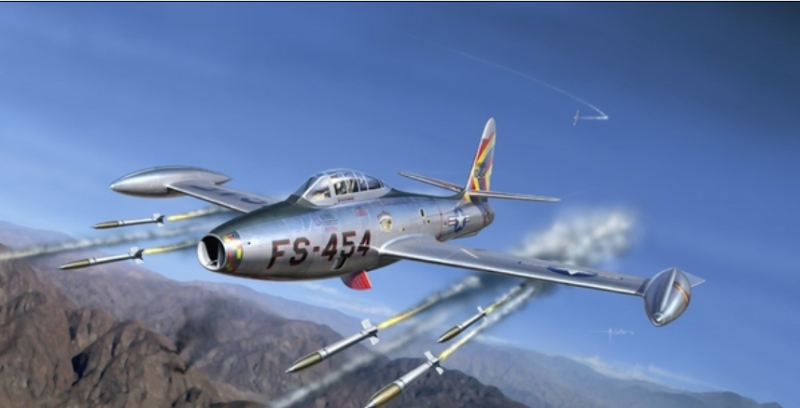
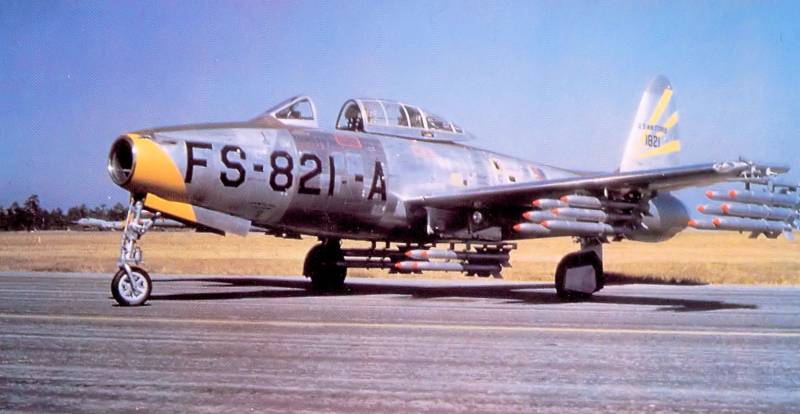
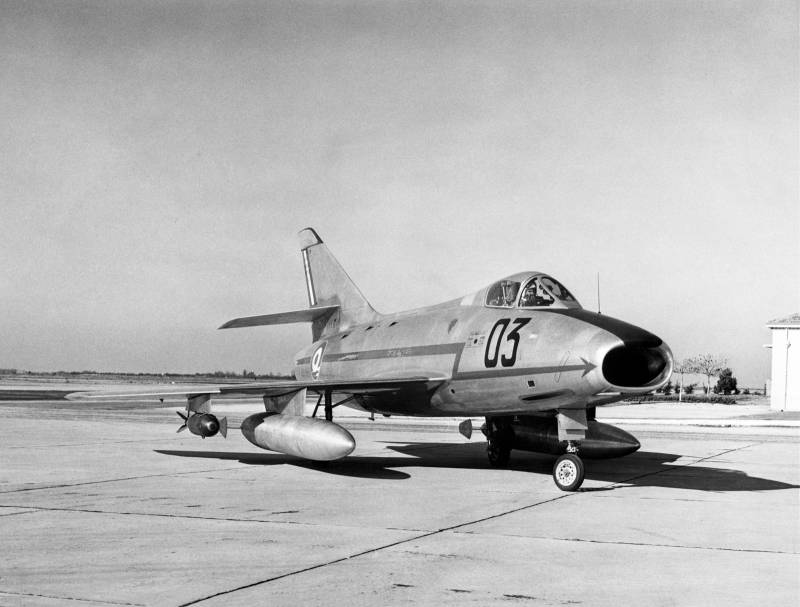
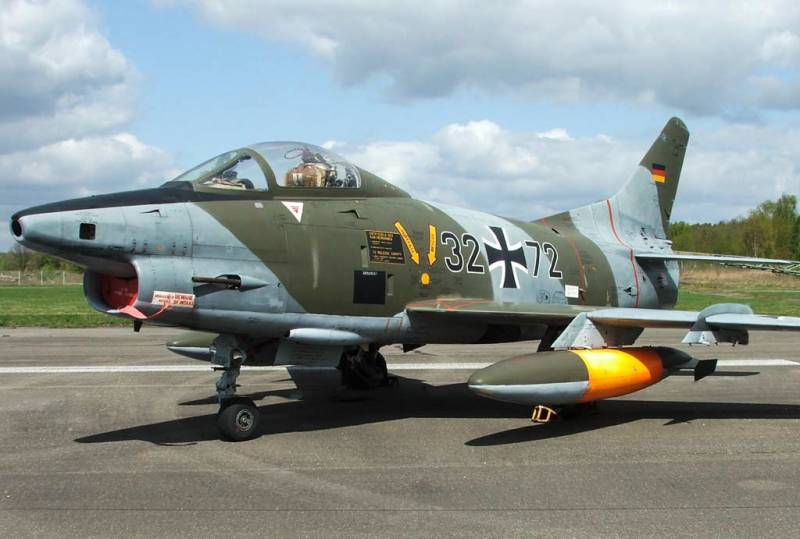
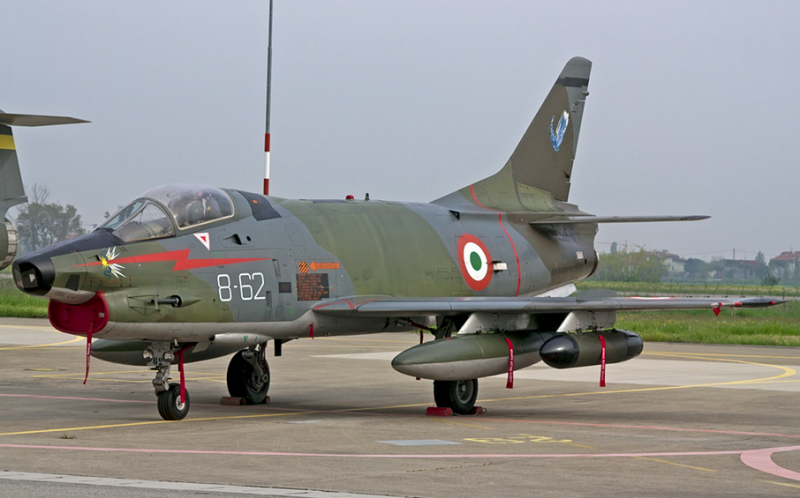
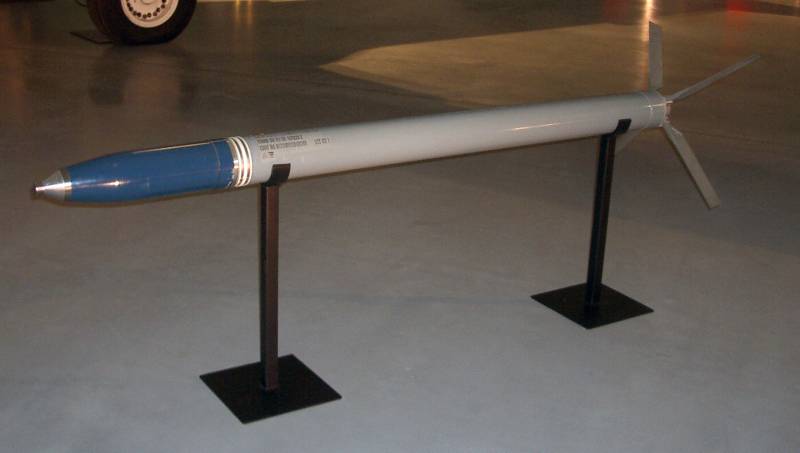
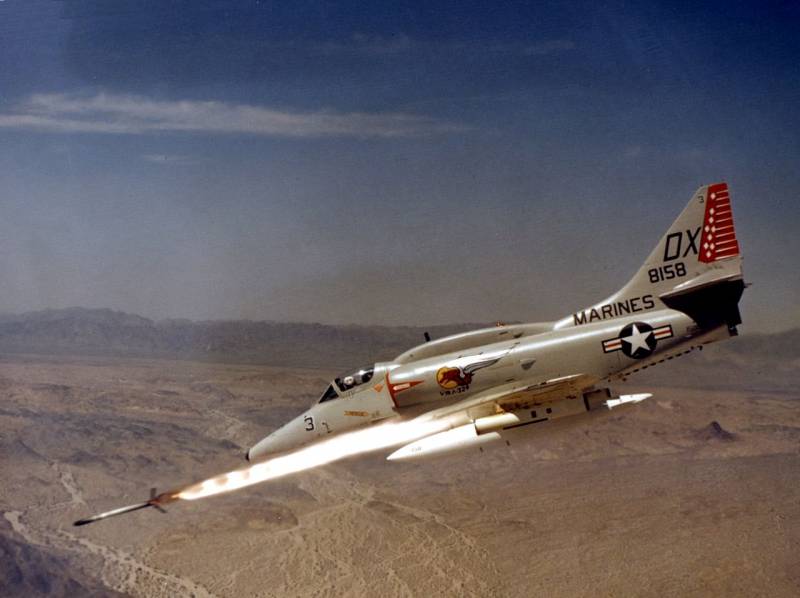
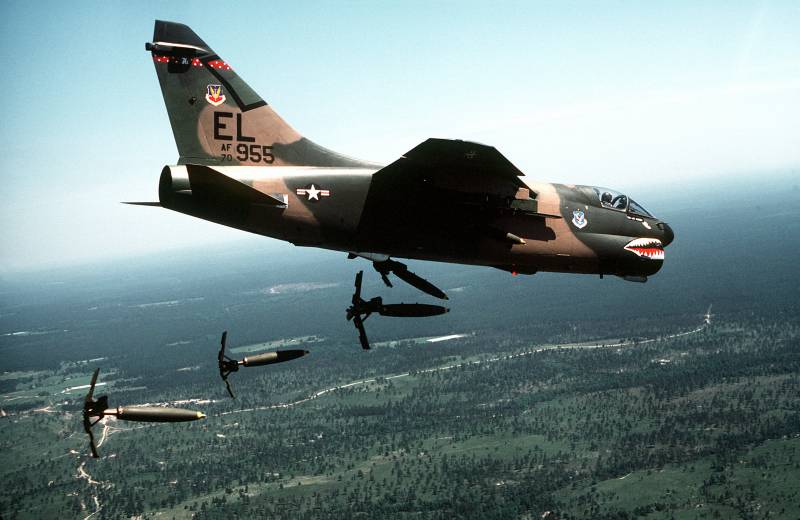
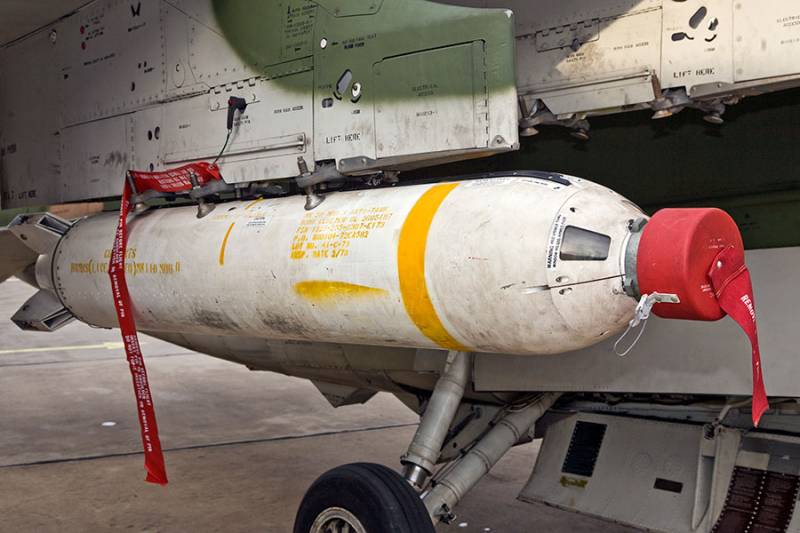
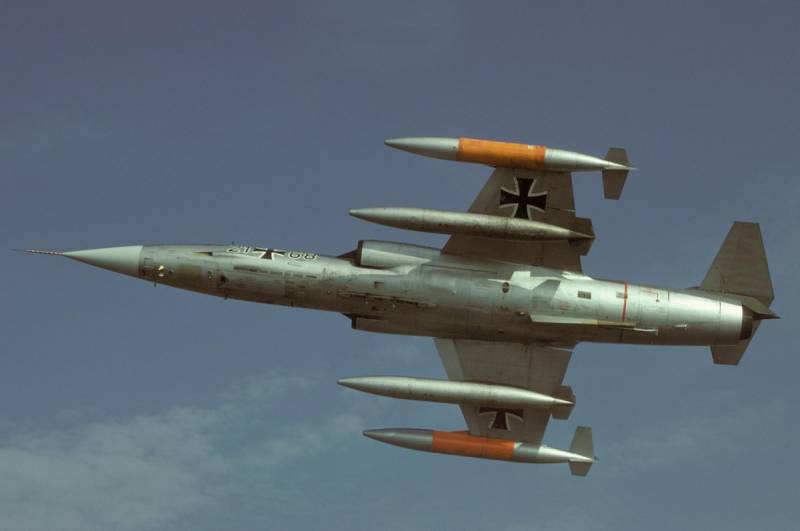
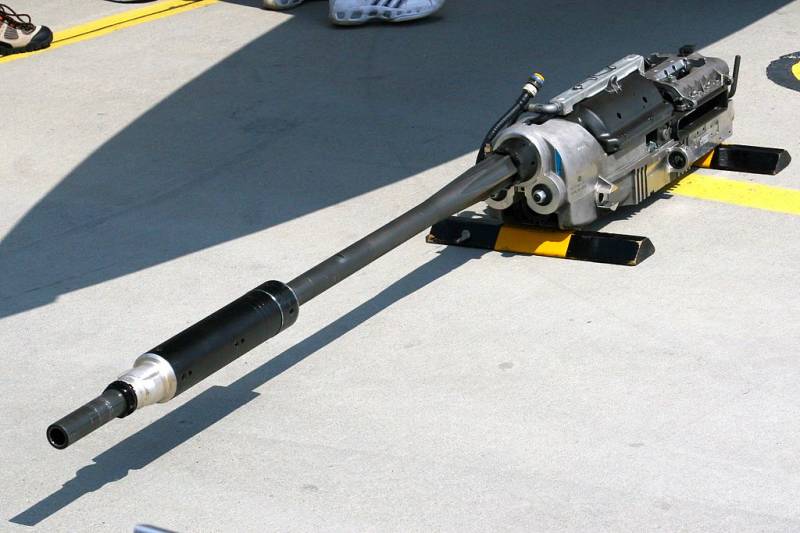
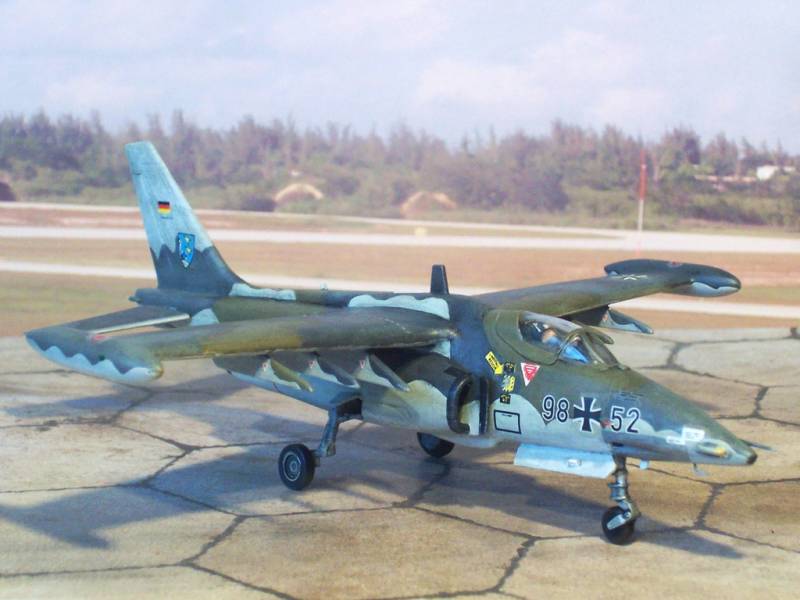
Information